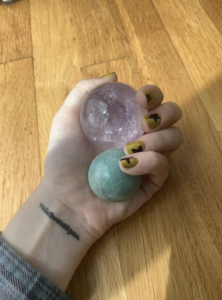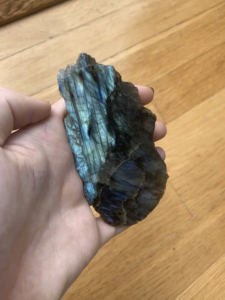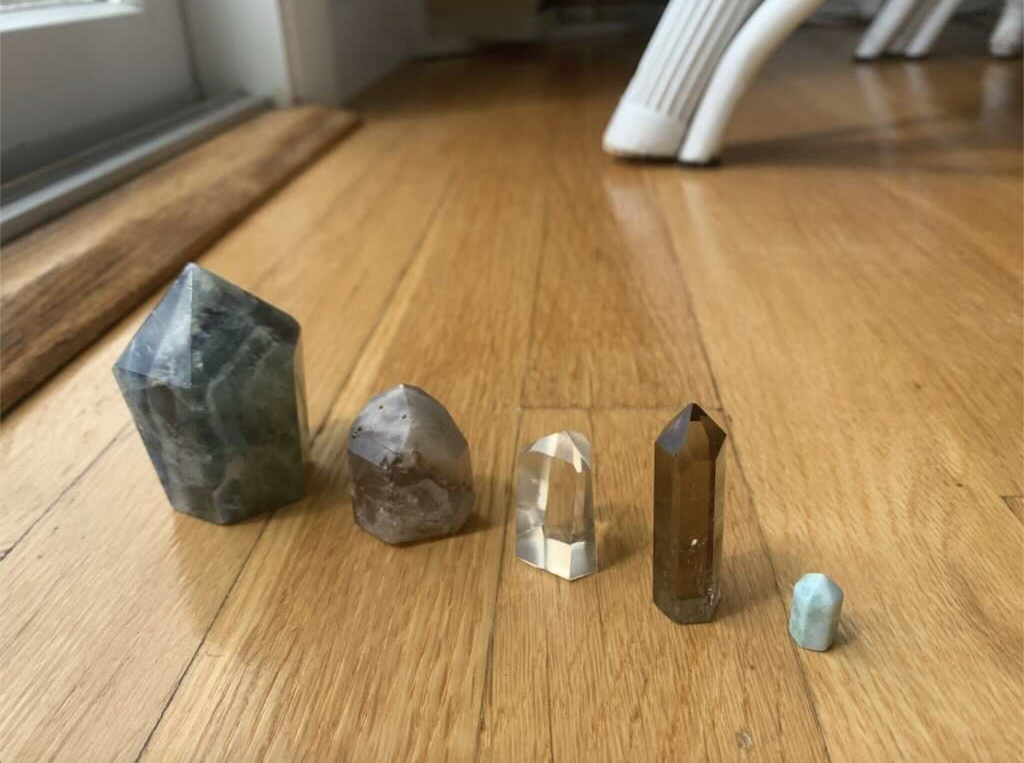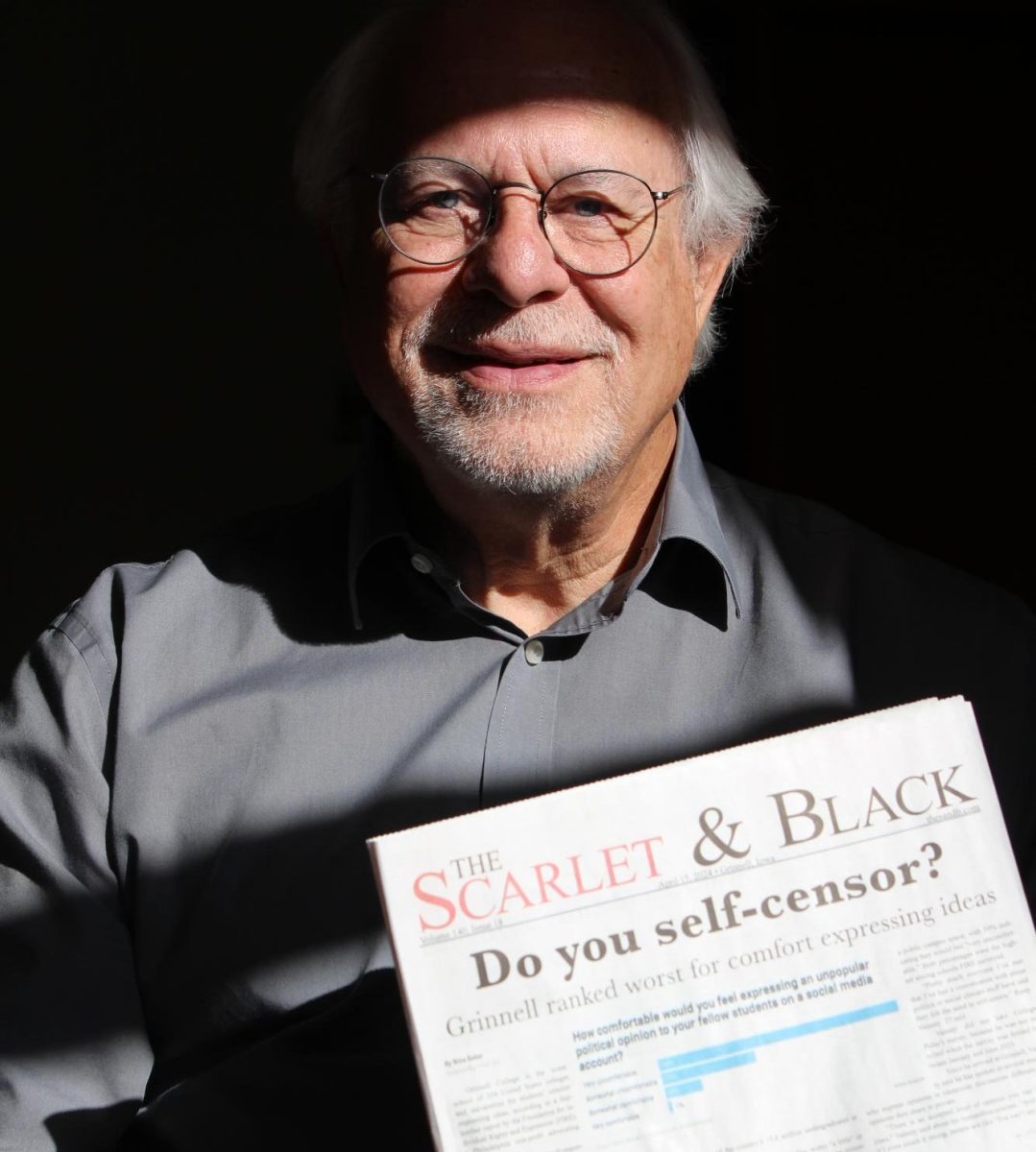By Eva Hill
hilleva@grinnell.edu
I’ve loved semiprecious stones – or “rocks and minerals,” as my favorite Scholastic Book Fair hardback referred to them – since I can remember. The East Coast of the United States, where I grew up, had plenty to offer: thick chunks of glittering mica, rough mottled pink granite, pale quartz ovals and dark-grey slate slabs were an endless fascination for me on hikes and camping trips. A family friend also owned a rock tumbler, a rotating cylindrical box filled with stones and grit that, when spun for a day or longer, gave the stone pieces a near-mirror polish. I found those tumbled stones even more interesting. Their polished surfaces allowed a closer inspection of hairline fractures and fissures within the stone and even views into the interior of the piece for clear minerals like quartz, whose surface is cloudy when the stone is rough.
During the pandemic, though, there’s been little opportunity for me to go find rocks on beaches or mountains in my hometown in suburban Massachusetts. So, in a development unexpected to myself and mystifying to everyone else in my family, I found my way into the online semiprecious stone world this past winter. But that’s not how most people know it: when the subjects in question are carved or polished rocks, most people call them crystals.

Spiritual and “wellness”-related use of crystals is a massive industry among both mainstream and fringe groups with new-age spiritual leanings; I think most people remember Gwyneth Paltrow’s infamous yoni eggs, and it’s hard to find a beauty retailer that doesn’t sell some kind of facial massager made from stone, or some more dubiously useful gemstone products. My hesitancy to engage in a wider collector’s community came from the severe human rights violations involved in the mining, processing and sale of gemstones. Many stones come only from certain parts of the world, and the crystal boom has meant that large distributors and suppliers have been trying to source as much as they can as cheaply as they can – and, as it often does, this approach means that child slavery, forced labor, dangerous work conditions and environmental damage are rampant. All of the products linked in the first half of this paragraph are almost certainly linked to these issues, given the scale of the companies selling them and the lack of any ethical statement on the sale page.
It is possible, with enough research, to find ethical small-scale sellers of semiprecious stones. Generally, if a seller works closely with a small number of independent mine owners and artisans, and they know where and how their stones are being mined, polished and carved, and their prices don’t seem too good to be true, that’s as close as it’s possible to get to being sure the stones are ethically produced without mining them yourself. But my concerns with the “crystal wellness” world extend beyond the stones themselves.
The central idea of crystal healing and spirituality is that the crystals vibrate at frequencies that “balance” or “cleanse” spiritual centers within the body. I have no particular problem with this belief on its own, although I don’t personally subscribe to it. However, my own history with mental illness leads me to be highly skeptical of any practice that suggests there’s a simple fix for depression, anxiety, insomnia, or any other mental condition. Some of the limited research on crystal healing indicates that any positive effect of crystal use comes from the placebo effect, which to me holds the risk of a real danger.
I’m not a stranger to nontraditional treatment methods, either; mindfulness meditation, which I wrote about in my now-defunct S&B wellness column over two years ago, forms a foundational part of my own mental self-care. But the difference is that mindfulness is supported by replicable scientific studies – all available reputable research on crystals, on the other hand, points to belief as the sole cause of effectiveness.

At this point, you’re probably wondering why I even bother lurking in the online gemstone world the way I’ve done this year – and to be honest, so am I, sometimes. I’ll say that it’s been interesting and educational to be able to observe other people’s participation in this culture or community, and also oddly freeing to have a place where it’s perfectly normal to talk about a particular area of blue iridescence on a piece of labradorite. My relationship to gemstones and stones in general has stayed much the same; I’m still primarily fascinated by the intricate structural individuality of each rock, the way none of them are exactly the same. For me, as someone who likes to focus my meditation practice on a real-world visual, they’re effective aids in the same way that a white noise track and a well-organized space are.
Despite my initial ignorance and subsequent lack of belief in the healing properties of individual stones, I do think that I use gemstones as a component of how I take care of myself, even if it’s not in the “traditional” way. But that doesn’t do much to quell my worries that some believers may try to use crystals as their first or only solution to mental – or physical – health problems, much less the certainty that many buyers won’t do their research before starting a collection, resulting in a human cost much higher than anything a chunk of polished tourmaline could fix.
Any opinions expressed through columns and other S&B opinions publications belong to the writer and do not reflect the views of any or all members of The S&B staff, nor by any Grinnell associated organization.



































































